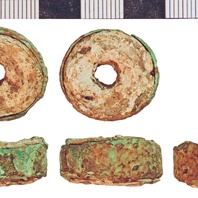
Viking Objects
Copper-Alloy Edged Lead Weight (NLM-E6E083)
A lead weight edged with a copper-alloy band. The distinction of weights by embedded objects or other embellishments in various media is a widely recognised feature of some early medieval weights. The object has also been identified as a spindle whorl, though this is less likely. If a weight, it is perhaps an indicator of the Scandinavian bullion economy. Weights are an important form of evidence for Viking Age commerce and the use of standards across the different economic systems within which Vikings were integrated. Many of the weights discovered, particularly ones in Ireland and those of Arabic type, suggest that a standardized system of weights existed in some areas. These standard weights, alongside standard values of silver, are what allowed the bullion economy of Viking occupied areas to function. A bullion economy was a barter economy that relied on the exchange of set amounts of precious metal in various forms, such as arm-rings or coins, for tradable goods, such as food or textiles. Each merchant would have brought their own set of weights and scales to a transaction to make sure that the trade was conducted fairly.
Read More
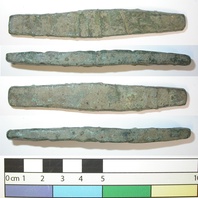
Viking Objects
Copper Alloy Ingot (1986/975-AE29)
This copper alloy ingot was found at the Little Chester Roman fort site near the Roman defences of Derby. This item, alongside others found in the ditches and structures close to the Roman defences, suggests a high level of activity in the area and a significant early medieval presence at this stronghold. Being found in proximity to a stone mould, it is likely that this ingot was used for metalworking, probably of jewellery. Similar ingots are known from Viking period contexts in northern Europe, as at Birka and Lund.
Read More
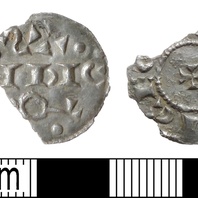
Viking Objects
Viking Silver Penny (DENO-7A0AF7)
An incomplete silver early medieval penny of the Vikings possibly minted in the name of Sihtric and imitating swordless St Peter Two-Line Type coins which were minted in York, c.905-920. Sihtric Caoch was the Scandinavian ruler of Dublin from 917-920 CE and subsequently the ruler of Northumbria from 921-927 CE. It is not certain why he left Ireland. The Irish annals state that it was ‘through the grace of God’ and do not elaborate on the politics behind his departure. After the establishment of the Danelaw, some Viking leaders decided to mint their own coins to solidify their legitimacy in the eyes of the local populace. This created a hybrid economy where some members of the Danelaw used bullion and others used coins.
Read More
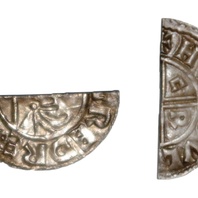
Viking Objects
Aethelred II Penny (LIN-8887C3)
A cut CRUX-type penny minted by Hundulf of York on behalf of King Aethelred II. While this coin is Anglo-Saxon, the fact that it has been cut may suggest that it was used as a part of a bullion transaction in line with the dual bullion-monetary economy established by the Vikings in England.
Read More
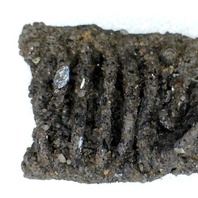
Viking Objects
Silver Wire Embroidery (1988/225-16)
This silver wire was found in Mound 11 at Heath Wood, Ingleby, Derbyshire. This burial mound contained fragments of the remains of an adult human together with the cremated remains of animals, including a small dog, a horse and sheep. The burial was accompanied by this silver wire, an iron spade shoe, some small iron nails and some corroded metalwork. The silver wire was found in two parts with traces of carbonised fibres attached. This suggests that it was probably attached to a piece of cloth. Silver and gold embroidery are known from a number of Viking Age graves, including from nearby Repton, Derbyshire, as well as further afield, e.g. Birka, Sweden. At Birka, wire embroidery was found on caps and headbands, although there is no reason to think that it was only used on headgear at all times.
Read More
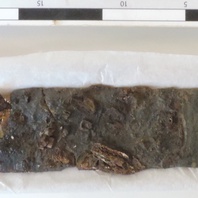
Viking Objects
Sword Blade (1987/590-2)
This fragment of a sword blade was found at the Viking cemetery at Heath Wood, Ingleby in Mound 1. It is incomplete and consists of a 385mm long section of the blade with a rounded tip. the blade has a fuller down the middle to reduce weight. The sword would probably have been over 900mm long when complete, so less than half the blade survives.
Read More
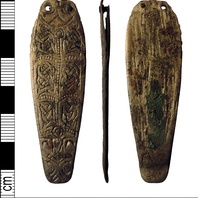
Viking Objects
Anglo-Saxon Zoomorphic Strap-End (NCMG 2003-27; T2001:2 ; 2002 T21)
A large silver strap-end with simple chevron decoration and six incised panels of ribbon knotwork divided by curved laddered frames. This strap-end is typical of ninth-century Anglo-Saxon design from the Yorkshire school. The border design is also found on the Trewhiddle type but due to its lower quality execution this strap-end is probably an imitation. Strap-ends came in various styles and were fairly common throughout the Viking world. They were used to decorate the ends of belts and to stop them getting damaged.
Read More
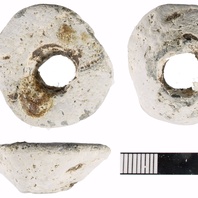
Viking Objects
Lead Spindle-Whorl (NLM-1E7FD8)
This cast lead spindle-whorl is classed as a Walton Rogers A1 type and, due to its mass, it was likely used for spinning yarn. Fibres were spun into thread using a drop-spindle of which the whorls were made of bone, ceramic, lead or stone and acted as flywheels during spinning.
